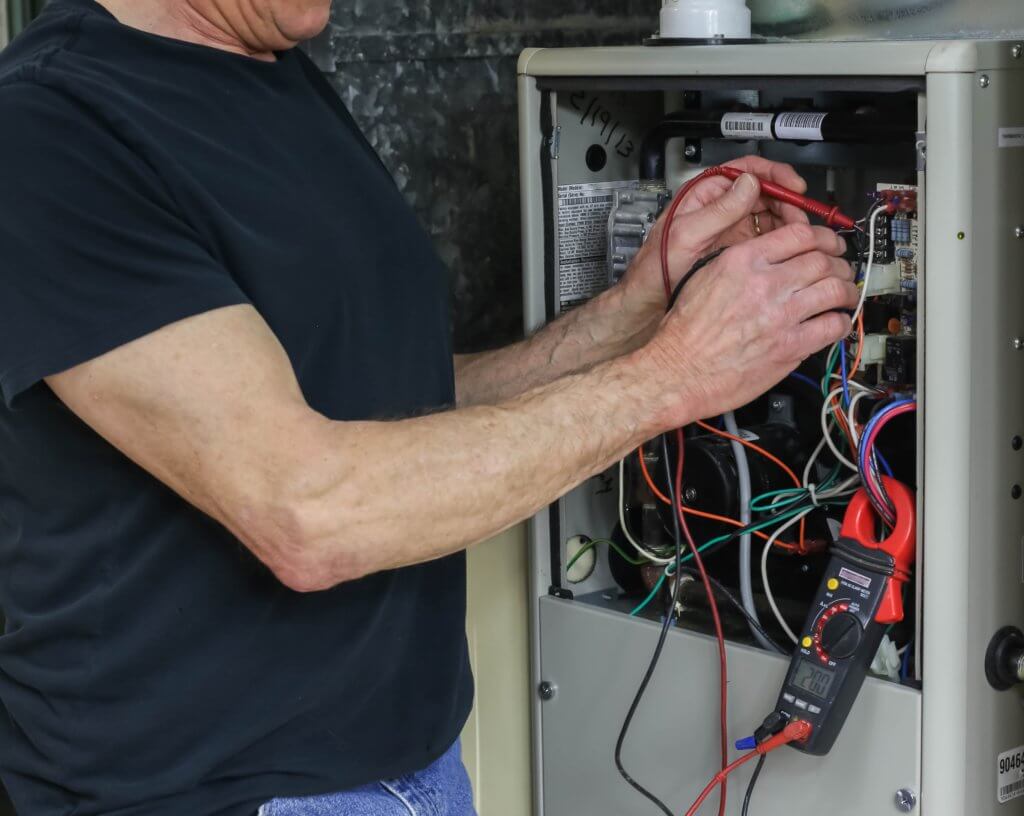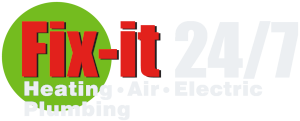Furnace Troubleshooting Guide to Solve Common Furnace Problems

Your furnace is crucial for keeping your home and family healthy and comfortable when Old Man Winter arrives. Without a working heater, you would have to endure torturous nights and mornings with lots of layers. It’s a good idea to know how to solve common furnace problems in a pinch.
Proper heating maintenance in the fall of every year can prevent most furnace problems in winter. Unfortunately, like any complicated pieces of machinery, furnaces eventually develop problems and require repairs and/or replacements.
In order to keep your heating system running strong, it’s important to catch and fix furnace problems early before they turn into expensive emergencies.
Here’s a list of potential furnace problems you may have and how to troubleshoot and fix them if possible:
If Your Furnace Won’t Turn On or Won’t Stay On:
1. Dirty Filters (Airflow)
Dirt and dust can clog the filters and negatively impact your airflow, energy efficiency, and indoor air quality. Since dirty air filters are bad for your indoor air and the health of your HVAC and duct system, newer models will automatically turn themselves off if they detect a clogged filter.
If the furnace won’t turn, on the first thing you should check is the air filter. Hold the filter up to the light to see if light can pass through or not. If you can’t see light through the filter, it’s a good idea to replace it. Write the date of replacement on the air filter and store multiple back-ups. Upgrade to a MERV (Minimum Efficiency Reporting Value) rating of at least 7 for better air filtration.
Follow manufacturer instructions when replacing the air filter. Remember that the arrow goes in the direction of the airflow. Make sure you close the access panel completely. Some furnaces won’t turn on if the filter and access panel aren’t properly installed.
2. Circuit Breaker (Power)
After checking for a dirty air filter and improperly secured access panel, the next thing you should check is the power supply to your furnace. Check the circuit breaker to see if the furnace tripped the breaker.
When flipping a circuit breaker, flip it all the way to the “off” position before resetting power. Make sure your hands are dry and you are not in contact with any water.
If the furnace is receiving power from the electrical panel, check the on/off switch near the indoor air handling unit. If it has been accidentally flipped “off,” you’ll want to flip it back on again.
Contact a professional if your furnace isn’t receiving power or if it continues to trip the breaker. A frequently tripping breaker is a sign of a larger electrical problem.
3. Thermostat (Communication)
Once you have inspected the air filter and power source, make sure your thermostat is working properly.
- Make sure thermostat is set to “heat.”
- Check that the thermostat is set to a temperature higher than the room temperature.
- Remove any heat sources that may be sending a false signal to your thermostat such as space heaters, cooking equipment, sunlight, and lamps.
- Your thermostat should be completely level. Reposition the thermostat if needed.
- If you have an electromechanical thermostat, you may need to open it up and give it a gentle dusting and cleaning. If you are experiencing short cycling or other cycling problems, try adjusting the anticipator.
- Change the thermostat batteries if necessary.
If your furnace still won’t turn on try resetting the breaker switch and thermostat. Turn the thermostat to “auto,” wait around 30 minutes and then turn it back to “heat.”
4. Pilot Light and Gas Valve (Ignition and Fuel Source)
If you have checked the filter, thermostat, and breaker box and your furnace still won’t turn on, you may have a problem with your fuel and ignition sources.
To relight a pilot light, follow the specific instructions in your owner’s manual (usually connected to the furnace). Make sure there are no gas fumes floating around by turning off your gas for 5-10 minutes first. Turn the gas back on to relight the pilot.
Make sure that the gas valve supplying your furnace is in the “on” position. The gas valve is “on” when the valve handle is parallel with the pipe.
5. PVC Pipe Vent Outside
If your furnace ventilates combustion gases outside via a PVC pipe, go outside and check that it isn’t clogged. Sometimes, you will find bird nests, leaves, snow, or other things clogging the ventilation pipe. This isn’t just dangerous as combustion gases can leak into the home, it can also prevent your furnace from running properly.
There’s one last thing you can do to try and restore power to your furnace:
- Turn the thermostat to “heat” but set the temperature much lower than the room temperature so the heater turns off.
- Find the breaker switch to your furnace and turn it off.
- Leave the breaker in the “off” position for 30 minutes or so before flipping it back on.
- Now, try setting your desired temperature to see if this “reset” did the trick.
How to Find and Solve Common Furnace Problems:
1. Check Furnace Filter
Your HVAC and duct system has been specifically designed for your home. TO facilitate airflow and energy efficiency, make sure you replace dirty air filters on time (30-90 days) and check your ducts, vents, and registers. Many furnace problems can be traced back to a dirty air filter.
Watch these videos to learn how to clean or replace your furnace filter:
2. Inspect Ducts, Registers, and Vents
Regardless of what you have heard about saving energy by closing off vents and registers in unused rooms, this is NOT a good idea. Go around your home and make sure all of your vents are fully open and unobstructed. Check under rugs and behind furniture and drapes.
You can inspect your ducts for air leaks by holding up a lit piece of incense or a thin piece of toilet paper. If you see the smoke or paper move with the air leak, you have leaky ducts. While it’s possible to seal some duct leaks yourself (using mastic sealant or aluminum foil tape, NOT duct tape), professional duct sealing and insulation is recommended.
Another way to improve efficiency and indoor air quality is by scheduling professional air duct cleaning every 5-7 years or so. Contact Fix-It 24/7 for professional air duct cleaning and indoor air quality service.
3. Furnace Flame Color
Check your furnace’s pilot light to make sure it is a healthy blue color. Any other color than blue (with perhaps a yellow/orange tip) indicates an inefficient and potentially dangerous combustion problem.
Other pilot light problems include:
- Flickering flames
- Flames longer than two inches or shorter than one inch.
- Purple, yellow, red, green, or any other color than blue.
Never attempt to fix your pilot light yourself (other than relighting it). Contact a professional HVAC technician for assistance.
If furnace cycles on or off too frequently:
1. Adjust thermostat anticipator
If you have a manual, electromechanically thermostat, you may need to adjust the anticipator to fix a furnace cycling problem. When making anticipator calibrations, only move one setting at a time.
Try moving the anticipator to the “longer” setting if your furnace has troubles reaching the desired temperature. After each adjustment, wait a couple hours to see if the problem is solved. Most anticipators work best when set between 0.2-0.8 amps.
2. Clogged Filter, Wrong Thermostat Setting, or Improper Airflow
Some of the other causes of furnace problems mentioned earlier can also have a negative impact on your furnace cycling. If your furnace is turning on or off too frequently, make sure you have a clean air filter, duct and registers are unblocked, and a properly set and programmed thermostat.
Furnace Troubleshooting Recap:
- Schedule annual professional furnace maintenance every fall season.
- Replace dirty air filter and secure access panels. Check your furnace filter every 30 days (set a calendar reminder).
- Make sure thermostat is set to “heat” and higher than room temperature.
- Check power switch near furnace and circuit breaker.
- Relight pilot light and check for “on” gas valve.
- Remove any obstructions around air duct vents and registers.
- If none of these furnace troubleshooting tips worked, contact a professional HVAC company.
Furnace Maintenance Tips
Use the U.S. Dept. of Energy infographic below for more tips on maintaining your furnace and saving money & energy:
If you experience any furnace problems, contact a licensed Denver Heating specialist at Fix-It 24/7.
Fix-It 24/7 Plumbing, Heating, Air and Electric provides reliable, on-time heating service 24 hours a day, 7 days a week. Call us now at (303) 214-0277 or schedule service online.
Service You Can Count On
We came from humble beginnings, having started as just a small family
business. And while we’ve experienced growth, Fix-It 24/7





